Schönbrunn Palace is the former summer residence of the imperial family. Ever since it was completed in 1780 during the reign of Maria-Theresia, the palace was the favorite residence of the Habsburg monarchs.

The palace lies about six kilometers (four miles) from the center of Vienna, but is easily reached by the underground. The whole area, including the expansive garden, occupies about 176 hectares or 435 acres, and you’ll have to set aside at least a half day for a visit to Schönbrunn’s magnificent palace and garden.
History
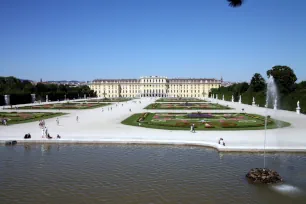
After Emperor Maximilian II acquired the site of the current palace – then known as Katterburg – in 1569 he converted the existing castle into a hunting lodge. The story goes that his son, Emperor Matthias, discovered a beautiful spring while hunting here, and he exclaimed ‘So ein schöner Brunnen’ (what a beautiful spring), which led to the name Schönbrunn.
In 1695, after the Turkish destroyed the hunting lodge, Emperor Leopold I commissioned court architect Johann Bernhard Fischer von Erlach with the construction of a palace that was to outshine Versailles. Due to costly wars, Fisher von Erlach’s proposed complex of multiple wings and terraces set on a hill (now the site of the Gloriette) was too expensive, and the emperor had to settle for a more modest design. Construction started in 1696, but it was only partially completed when Leopold I died in 1705.
Even though his successor Joseph I spent much of his time in the completed section of the complex, little progress was made until the mid-eighteenth century, when Maria Theresia commissioned court architect Nicolaus Pacassi with the completion of the palace.
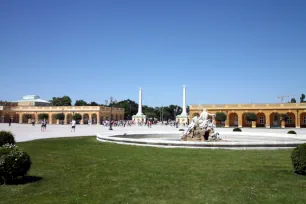
In 1918, Charles I renounced involvement in state affairs, effectively ending the reign of the Habsburg monarchy, after which the palace became state owned.
The Palace
A main gateway flanked by two obelisks leads to the vast courtyard, decorated with two large fountains, one with allegorical figures depicting the rivers Danube, Inn and Ems and the other with sculptures representing Transylvania, Galicia and Lodomeria. Right ahead is the main palace building of the complex, with the large garden behind. To the right is the Schönbrunn Court Theatre, built in 1767 in Rococo style.
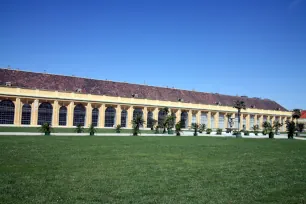
Gates on the right and left open up towards the garden, from where you have a better view of the whole complex. On the left seen from the garden is the Wagenburg (Coach Room), which houses the imperial collection of coaches, sledges and carriages. To the right is the Orangery, where plants and flowers were housed during wintertime to protect them from inclement weather.
The central palace is 175 meters (574 ft) wide and has a symmetrical Baroque facade. All buildings were painted in a typical light yellow/ocher pattern, a combination that was soon copied by many residences around the country.
Interior
During its heyday, some 1,000 people lived in the 1441 rooms and halls of the complex. Forty of these rooms – grand state apartments and the rooms of Franz-Josef and Elisabeth (Sissi) – are open to visitors.
The Rococo style interior of the Schönbrunn apartments is much more luxurious than the rather sober apartments in the Hofburg.
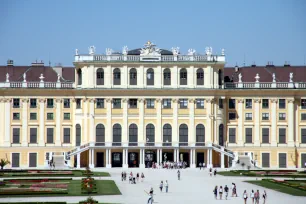
Some, in particular the Millionenzimmer (Millions Room), are particularly sumptuous. Other remarkable rooms include the round Chinese Cabinet, a room decorated with porcelain. In this room, empress Maria Theresia held meetings with advisors. In the Blue Chinese Room – decorated with blue Chinese motifs – Charles I set his signature to hand over state affairs in 1918. A much darker room is the Vieux-Lacque room, where Maria Theresia spent much of her time after she became a widow. The Spiegelsaal (Mirror Hall) was the setting for a duet of a young Mozart and his sister in front of Maria Theresia. Nearby is the Rosa Room, named after the artist who created the frescoes of landscapes on the walls. The private rooms of Franz-Joseph and empress Elisabeth have less elaborate decorations. The emperor held audiences in the Walnut room, named for the wooden Rococo paneling.
Schlosspark
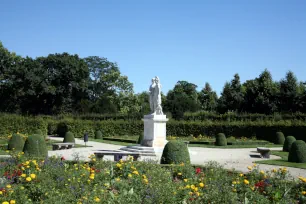
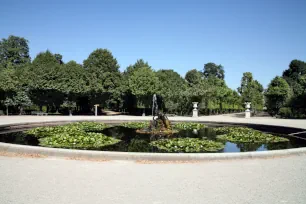
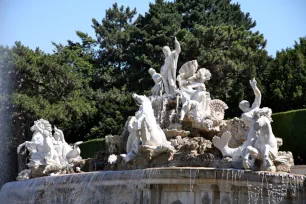
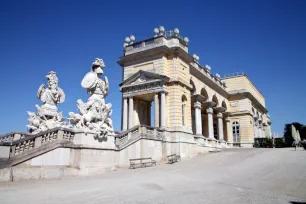
The vast park is situated on a sloping site behind the palace, originally a hunting ground. It was laid out in 1705-1706 by Jean Trehet in a formal French style. Between 1753 and 1775, during the reign of Maria-Theresia, parts of the park were redesigned as a Baroque landscape by Ferdinand von Hohenberg.
The center of the park still consists of formally aligned flowerbeds flanked by rows of statues. They lead to the large Neptune fountain. Around the flowerbeds are formal gardens arranged in a star shape around two fountains known as the Najadenbrunnen. Behind the Neptune fountain, a zigzagging path leads to the Gloriette, an impressive arcade on top of the Schönbrunn Hill. The area around the Gloriette is less formal and even has some forest-like areas.
Throughout the park are a number of monuments, buildings, and architectural follies such as a mock Roman ruin and a large obelisk.
Neptune Fountain
One of the highlights of Schönbrunn is the Neptune Fountain or Neptunbrunnen, the park’s most monumental fountain. It was built in 1780 by Franz Anton von Zauner, an Austrian sculptor. The Baroque sculpture group depicts a mythical scene in which the sea goddess Thetis asks Neptune to allow her son Achilles a safe voyage to Troy.
Gloriette
The crowning glory of the park is the Gloriette, a neoclassicist arcaded structure perched on top of the Schönbrunn hill. In the original plans of Johann Bernhard Fischer von Erlach for Schönbrunn, the palace would be built here, with large terraces on the slope towards the city.
Instead, the Gloriette was built here in 1775 by Ferdinand von Hohenberg as a monument to the soldiers who had given their lives for the empire. From the Gloriette you have a magnificent panoramic view, not only over the park and palace, but also over the city of Vienna. The Gloriette is home to a café where you can relax after the uphill climb.
More attractions in the park
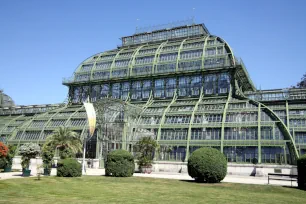
On the western side of the park is the magnificent steel construction of the Palmenhaus (Palm House), built in 1883. Inside, you’ll find a number of exotic plants in different climate zones.
Nearby is the Tiergarten (zoo). Maximilian II already kept a collection of exotic animals here, but the current zoo dates back to 1752, during Maria Theresia’s reign. The zoo is now modernized and is home to a variety of animals such as elephants, apes, hippopotamus, koalas and many more.
To the left of the Neptune Fountain is a mock Roman Ruin, built by Ferdinand von Hohenberg in 1778. Such ruins were all the rage at the time, and provided a romantic backdrop for theater productions. Nearby lie the Schöner Brunnen that gave the domain its name. A small pavilion, decorated with the statue of a nymph, is built over the spring.
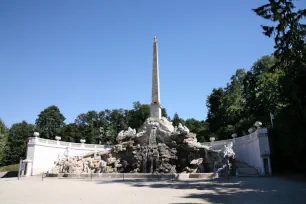
Further east is one of the park’s most impressive architectural follies: a tall obelisk erected on top of a monumental cascade. The mock hieroglyphs on the obelisk recount the history of the Habsburg family.
More sights in the park include a Botanic Garden; a Japanese garden; the beautiful Taubenhaus – a dovecote; the Najadenbrunnen – two similar fountains; the Meierei (dairy farm), now a café-restaurant; the labyrinth – a recreated version of the original seventeenth century version; and the Wüstenhaus, a hothouse near the Palmenhaus with plenty of cacti.
- Next: Michaelerplatz
- More Sights & Attractions in Vienna

